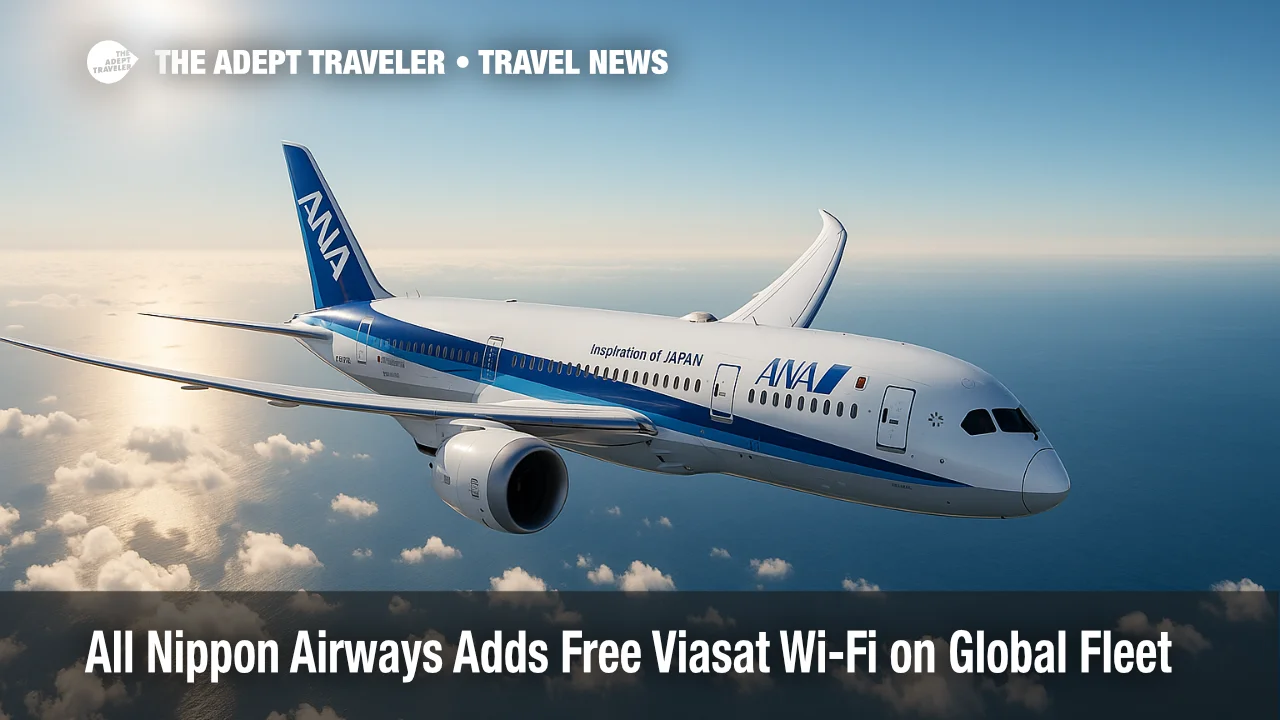All Nippon Airways Adds Free Viasat Wi-Fi on Global Fleet

Japan's All Nippon Airways will begin offering complimentary, high-speed Viasat Wi-Fi on the majority of its international aircraft with the launch of the winter 2025-26 schedule. The move places ANA among a growing group of carriers-including Delta Air Lines, Qatar Airways, and Qantas-that now view fast, free inflight internet as a baseline service rather than a paid perk. Retrofits will start with six Boeing 767-300ERs, followed by line-fit installations on incoming Boeing 787-9 and 777-9 jets, covering more than 80 percent of ANA's long-haul fleet by 2030.
Key Points
- Why it matters: Free Wi-Fi is becoming an industry standard.
- Travel impact: Passengers can stream, work, and message gate-to-gate at no cost.
- What's next: 767 retrofits finish by March 31, 2026; new 787-9s arrive factory-wired.
- Competitive angle: Delta, Qatar, and Qantas have set the benchmark for gratis connectivity.
- Tech note: Viasat's Amara antenna supports multi-orbit Ka-band service.
Snapshot
Beginning with this winter's timetable, ANA flyers in every cabin can connect to Viasat's Ka-band network from boarding to de-planing on most long-haul routes. The initial six 202-seat 767-300ERs will be re-equipped first, restoring connectivity that had lapsed when SITA exited the market. Newly delivered 787-9 and 777-9 aircraft will roll off Boeing's line already fitted with Viasat hardware capable of switching to future low-Earth-orbit satellites for added bandwidth. ANA projects fleet-wide international coverage above eighty percent by the end of the decade.
Background
ANA has long offered paid Ku-band and Inmarsat Ka-band access on wide-body jets, with free vouchers only for premium-cabin guests. Pressure grew after Delta unlocked free Viasat Wi-Fi on domestic flights in 2023 and began expanding the benefit to select intercontinental routes in 2024. Qatar Airways accelerated expectations further by outfitting its Boeing 777 fleet with complimentary Starlink in early 2025, while Qantas started activating Viasat-3 service on Asia-bound Airbus A330s the same year. With Japanese rivals also upgrading connectivity, ANA chose to leapfrog to an all-class, all-flight free model.
Latest Developments
Global shift toward free Wi-Fi gains steam
Delta now offers fast, free Wi-Fi on more than 720 aircraft and is adding wide-body routes as additional satellites come online. Qatar Airways completed Starlink retrofits across its 777s in July 2025 and has begun work on Airbus A350s, promising download speeds up to 500 Mbps. Qantas is progressively activating free satellite service on A330s and 787s ahead of its ultra-long-range Airbus A350 debut. Against this backdrop, ANA's move ensures that Tokyo Haneda International Airport (HND) and Narita International Airport (NRT) travelers will soon enjoy parity with peers on trans-Pacific and European sectors. For details on ANA's program, see the carrier's Wi-Fi page (https://www.ana.co.jp/en/jp/guide/inflight/service/international/wifi/?utm_source=adept.travel).
Analysis
Widespread adoption of free inflight Wi-Fi reflects both competitive necessity and shifting passenger expectations. Business travelers increasingly demand seamless connectivity for video conferencing, collaborative tools, and cloud services, while leisure flyers view unlimited streaming as table stakes. Airlines offset the installation and bandwidth costs-often topping $500,000 per wide-body-through sponsorship deals, loyalty-program data leverage, and higher customer satisfaction scores that justify premium fares. Viasat's Amara antenna gives ANA a future-proof asset capable of linking to multiple satellite constellations, reducing coverage gaps on polar routes. The timing also dovetails with ANA's fleet-renewal cycle; equipping aircraft at the factory minimizes downtime and labor expense. For travelers, the change erases another cost variable and simplifies trip planning. For the industry, it signals that the pay-per-megabyte era is rapidly ending.
Final Thoughts
As free Wi-Fi becomes as expected as seat-back screens, ANA's decision secures its position among tech-forward global carriers and raises the bar for connectivity across Asia-Pacific skies. Passengers departing Tokyo this winter can look forward to browsing, streaming, and working without pulling out a credit card, reaffirming that the future of flight is one where information flows as freely as the cabin air-powered by truly free Wi-Fi.
